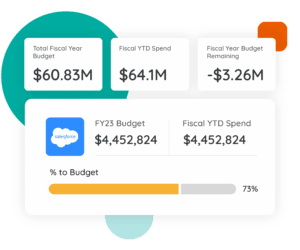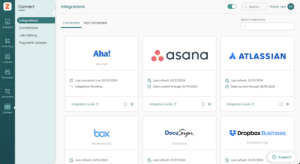Table of Contents
The pandemic skyrocketed SaaS growth as teams acquired the apps they needed to be productive and collaborative from their home offices. The result? SaaS now accounts for the second-largest budget line item, next to headcount.
Today, the average organization spends $49M annually on SaaS. That number rises to $284M for large enterprises with 10,000+ employees, and continues to grow. Gartner forecasts end-user SaaS spending to reach $299B in 2025, an 19% increase from the previous year. And they’re predicting it to increase 15-20% annually.

As a CFO, if you’ve let SaaS spend sprawl over the last couple of years, now’s the time to rein it in. This requires visibility into your company’s full SaaS stack — a difficult feat with apps purchased piecemeal by individual lines of business over the years.
In order to control SaaS spend, CFOs need to know:
- How much money the company spends on SaaS
- Who purchases SaaS
- How SaaS is acquired
- What SaaS adoption and utilization looks like at your organization
Learn how you can drive massive savings on your SaaS spend by understanding what you have in your portfolio.
4 Benefits of SaaS Spend Visibility for CFOs
Armed with deep SaaS insights, CFOs make more informed spending decisions for the company. This visibility comes from prioritizing SaaS inventory management. Read on for the benefits of SaaS visibility.
1. Find Hidden Spend
 CFOs can’t optimize what they can’t see. Because SaaS permeates our everyday lives — LinkedIn Premium, Slack, Zoom, Spotify, Canva — employees don’t think twice about downloading their preferred apps for business needs. In fact, Zylo data on employee spending shows nearly 1 employee out of 15 (6.6%) expenses SaaS.
CFOs can’t optimize what they can’t see. Because SaaS permeates our everyday lives — LinkedIn Premium, Slack, Zoom, Spotify, Canva — employees don’t think twice about downloading their preferred apps for business needs. In fact, Zylo data on employee spending shows nearly 1 employee out of 15 (6.6%) expenses SaaS.
This leads to hidden costs caused by duplicate purchases, redundant apps, mischaracterized software, and unplanned renewals.
Beyond basic SaaS discovery, utilization metrics uncover wasted spend by showing unused software licenses.
2. Empower Better Spend Management
With visibility into your company’s full SaaS stack, CFOs and IT asset managers can work together with department managers to discover and reallocate those hidden costs, and implement a SaaS spend management strategy.
SaaS spend management refers to identifying costs, increasing savings, and maximizing the value of your SaaS stack. To start, businesses should reduce underutilized licenses, trim apps with overlapping functions, and consolidate duplicate subscriptions under better negotiated terms.
And to control sprawl, CFOs must create a process for how SaaS enters the organization going forward.
3. Future-Proof Your Organization
From the pandemic to supply chain issues, the last couple of years drove home the importance of planning for the unexpected. Entrepreneur magazine lists getting the most out of your tech investments as one of the top three ways to future-proof your business.
CFOs who find hidden costs and implement a SaaS spend management strategy help their organizations trim their IT budgets. The added benefits? You can reallocate the savings toward a financial buffer that protects your business in the long run.
4. Budget for the Future
Shadow IT makes forecasting technology investments difficult. As mentioned earlier, hidden costs lurk throughout the organization when employees acquire their own SaaS tools through corporate credit cards. SaaS discovery and optimization puts you in a better position to forecast and budget for years to come.
 When planning your IT budget, consider the following questions:
When planning your IT budget, consider the following questions:
When do I need to begin preparing for SaaS renewals?
Experts recommend preparing for SaaS renewal 30-90 days before the renewal date. This allows time to examine the app’s utilization rate and ROI, and make a strategic decision on whether to renew.
Is the business investing in the right software?
Through survey data, stakeholder meetings, and actual utilization metrics, decide whether your company’s invested in the right tools. Measure SaaS effectiveness SaaS through a high utilization rate and employee satisfaction.
How do I measure the utilization of an application?
You can request utilization data from the vendors themselves, but this process takes a significant amount of time and effort, not to mention the vendors have a huge stake in showing high utilization rates.
With Zylo’s direct integrations, customers receive accurate numbers of real-time usage and total licenses, provisioned licenses, and active licenses. And if there’s not a direct integration, Zylo still uncovers utilization data through your SSO solution.

How do I determine the number of app licenses needed per department?
Dig deep into those utilization metrics to forecast software licenses needed for the upcoming years. In cases of underutilization, find opportunities to reduce seats per tool or consolidate subscriptions into a single solution negotiation.
Who should I include in the process?
Since SaaS is acquired throughout an organization, include department managers in your fact-finding and discussions. They bring insight into reasons for underutilization and tools that may be flying under the radar.
Don’t forget IT. Even if they don’t own SaaS vetting and acquisition, they offer invaluable experience to help drive efficiency and ROI at your company.
Guide to Managing SaaS Costs
Learn MoreMake SaaS Budgeting Easier with a Cost Management System
According to Zylo data, 51% of transactions involving SaaS applications are not tagged as “software” in expense systems. And with the average organization spending approximately $4,000 on SaaS per employee, businesses can’t afford to let these costs fly under the radar.
A cost management system, or a system of record to report, plan, and control IT budgets, makes it easier to optimize your current tech stack and plan for the future. A cost management system includes:
- Basic application information
- Cost and spend details
- Ownership information
- Licenses, entitlements, and features
- Term and renewal information
Those metrics combined provide the 360-view needed to optimize SaaS costs now and plan for the upcoming quarter or fiscal year.
As a CFO, are you ready to take charge of your tech budget and SaaS spend? Get started today with our Guide to Managing SaaS Costs.

